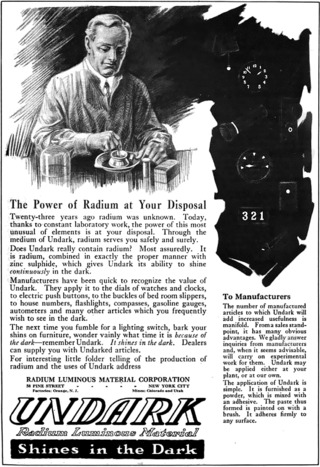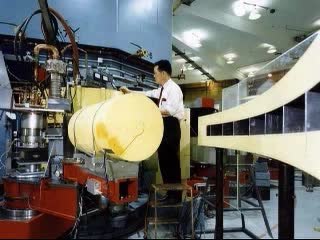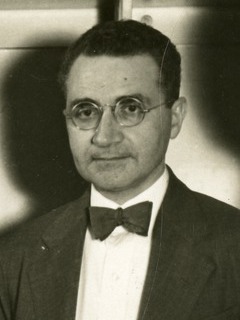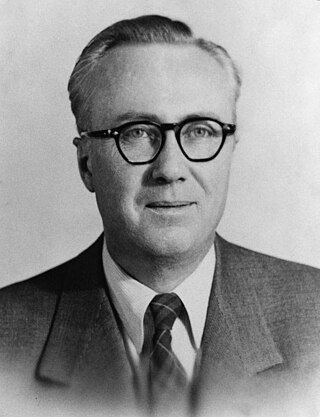Related Research Articles
Background radiation is a measure of the level of ionizing radiation present in the environment at a particular location which is not due to deliberate introduction of radiation sources.
The gray is the unit of ionizing radiation dose in the International System of Units (SI), defined as the absorption of one joule of radiation energy per kilogram of matter.
Absorbed dose is a dose quantity which is the measure of the energy deposited in matter by ionizing radiation per unit mass. Absorbed dose is used in the calculation of dose uptake in living tissue in both radiation protection, and radiology. It is also used to directly compare the effect of radiation on inanimate matter such as in radiation hardening.

The linear no-threshold model (LNT) is a dose-response model used in radiation protection to estimate stochastic health effects such as radiation-induced cancer, genetic mutations and teratogenic effects on the human body due to exposure to ionizing radiation. The model statistically extrapolates effects of radiation from very high doses into very low doses, where no biological effects may be observed. The LNT model lies at a foundation of a postulate that all exposure to ionizing radiation is harmful, regardless of how low the dose is, and that the effect is cumulative over lifetime.

Backscatter X-ray is an advanced X-ray imaging technology. Traditional X-ray machines detect hard and soft materials by the variation in x-ray intensity transmitted through the target. In contrast, backscatter X-ray detects the radiation that reflects from the target. It has potential applications where less-destructive examination is required, and can operate even if only one side of the target is available for examination.

Radium and radon are important contributors to environmental radioactivity. Radon occurs naturally as a result of decay of radioactive elements in soil and it can accumulate in houses built on areas where such decay occurs. Radon is a major cause of cancer; it is estimated to contribute to ~2% of all cancer related deaths in Europe.
The International Commission on Radiological Protection (ICRP) is an independent, international, non-governmental organization, with the mission to protect people, animals, and the environment from the harmful effects of ionising radiation. Its recommendations form the basis of radiological protection policy, regulations, guidelines and practice worldwide.
The International Commission on Radiation Units and Measurements (ICRU) is a standardization body set up in 1925 by the International Congress of Radiology, originally as the X-Ray Unit Committee until 1950. Its objective "is to develop concepts, definitions and recommendations for the use of quantities and their units for ionizing radiation and its interaction with matter, in particular with respect to the biological effects induced by radiation".

Undark was a trade name for luminous paint made with a mixture of radioactive radium and zinc sulfide, as produced by the U.S. Radium Corporation between 1917 and 1938. It was used primarily in watch and clock dials. The people working in the industry who applied the radioactive paint became known as the Radium Girls because many of them became ill and some died from exposure to the radiation emitted by the radium contained within the product. The product was the direct cause of radium jaw in the dial painters. Undark was also available as a kit for general consumer use and marketed as glow-in-the-dark paint.
Radiobiology is a field of clinical and basic medical sciences that involves the study of the effects of ionizing radiation on living things, in particular health effects of radiation. Ionizing radiation is generally harmful and potentially lethal to living things but can have health benefits in radiation therapy for the treatment of cancer and thyrotoxicosis. Its most common impact is the induction of cancer with a latent period of years or decades after exposure. High doses can cause visually dramatic radiation burns, and/or rapid fatality through acute radiation syndrome. Controlled doses are used for medical imaging and radiotherapy.
David A. Schauer, ScD, CHP, is executive director emeritus of the National Council on Radiation Protection and Measurements (NCRP). During his tenure a number of updated and new publications were issued by the Council.

The roentgen or röntgen is a legacy unit of measurement for the exposure of X-rays and gamma rays, and is defined as the electric charge freed by such radiation in a specified volume of air divided by the mass of that air . In 1928, it was adopted as the first international measurement quantity for ionizing radiation to be defined for radiation protection, as it was then the most easily replicated method of measuring air ionization by using ion chambers. It is named after the German physicist Wilhelm Röntgen, who discovered X-rays and was awarded the first Nobel Prize in Physics for the discovery.

Radiation dose reconstruction refers to the process of estimating radiation doses that were received by individuals or populations in the past as a result of particular exposure situations of concern. The basic principle of radiation dose reconstruction is to characterize the radiation environment to which individuals have been exposed using available information. In cases where radiation exposures can not be fully characterized based on available data, default values based on reasonable scientific assumptions can be used as substitutes. The extent to which the default values are used depends on the purpose of the reconstruction(s) being undertaken.

Astronauts are exposed to approximately 72 millisieverts (mSv) while on six-month-duration missions to the International Space Station (ISS). Longer 3-year missions to Mars, however, have the potential to expose astronauts to radiation in excess of 1,000 mSv. Without the protection provided by Earth's magnetic field, the rate of exposure is dramatically increased. The risk of cancer caused by ionizing radiation is well documented at radiation doses beginning at 100 mSv and above.
Exposure to ionizing radiation is known to increase the future incidence of cancer, particularly leukemia. The mechanism by which this occurs is well understood, but quantitative models predicting the level of risk remain controversial. The most widely accepted model posits that the incidence of cancers due to ionizing radiation increases linearly with effective radiation dose at a rate of 5.5% per sievert; if correct, natural background radiation is the most hazardous source of radiation to general public health, followed by medical imaging as a close second. Additionally, the vast majority of non-invasive cancers are non-melanoma skin cancers caused by ultraviolet radiation. Non-ionizing radio frequency radiation from mobile phones, electric power transmission, and other similar sources have been investigated as a possible carcinogen by the WHO's International Agency for Research on Cancer, but to date, no evidence of this has been observed.
The American Academy of Health Physics (AAHP) is a non-profit organization based in McLean, VA which serves to advance the profession of health physics through networking opportunities for members, certification of health physicists, and advisement to professionals to increase the application of health physics. The Academy has selective criteria for membership in the organization.
John Dunning Boice Jr. is an American radiation epidemiologist and health physicist.

Gioacchino Failla was an Italian-born American physicist. A pioneer in both biophysics and radiobiology, he was particularly noted for his work on the role of radiation as a cause of cancer and genetic mutation. He was born in Castelbuono in the Province of Palermo and emigrated with his family to the United States in 1906. After his retirement from Columbia University's Center for Radiological Research in 1960, he was appointed Senior Scientist Emeritus in the Radiological Physics Division of the Argonne National Laboratory in Illinois. He was killed in a car accident near the laboratory at the age of 70.

Leonidas D. Marinelli was the American radiological physicist who is best known for founding the field of Human Radiobiology and developing the Marinelli Beaker.
G. William Morgan, also known as George William Morgan, health physicist and founding member of the Health Physics Society. Morgan held key health physics positions at Oak Ridge National Laboratory, the Manhattan Project and the Atomic Energy Commission. Morgan was instrumental in developing the regulations that we know today as I0 CFR 20, the Standards for Protection against Radiation.
References
- ↑ Tenforde, TS (September 2004). "Future role of the NCRP in radiation health protection". Health Physics. 87 (3): 312–8, discussion 318-9. doi:10.1097/00004032-200409000-00014. PMID 15303070. S2CID 20332300.
- ↑ "An act to incorporate the National Committee on Radiation Protection and Measurements". Public Law No. 88-376 of July 14, 1964 (PDF). Retrieved August 3, 2017.